Mental health at work: Five charts on the challenge
 Getty Images
Getty ImagesPoor mental health in the workplace is costing UK employers more, according to a new report by consultancy firm Deloitte and mental health charity Mind.
With workers often scared to talk about being unwell, and a lack of funding available, these five charts show the extent of the challenge bosses face.
An increasing cost
The consultancy firm Deloitte said that a range of factors have contributed to a reported increase in cost.
Employees are spending unproductive hours at work when ill, rather than taking time off.
Some workers are also experiencing "burnout" as technology makes it easier to log extra time and check emails outside designated working hours, and more seem to be affected by mental health problems in recent years.
The overall number of sick days taken per employee fell from 5.3 to 4.4 between 2008 and 2018, while the amount of time lost because of mental health conditions went up.
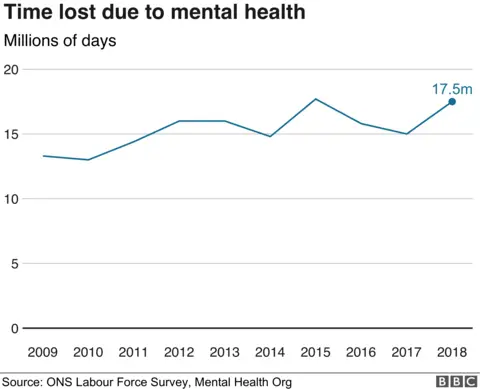
Part of the increase in cost also comes down to a rise in wages paid to workers over the last few years.
The new research by Deloitte suggests that poor mental health cost UK bosses more than £43bn in 2018.
That is an increase of 16% since the last estimate of £37bn in 2016.

How can you put a price on mental health?

The wages people are paid when they're on sick leave is one way to estimate the cost.
But people often don't disclose that sick leave is for mental health problems.
So the true costs could be higher.
On the other hand, if your work just waits for you to come back in, it's not costing your employer that much.
And measuring the cost of underperformance caused by mental health is even more tricky.
If you're making a case to bosses, you'll need to speak pounds and pence.
But mental health problems are often hard to pin down precisely and the numbers describing them are no different.

The study follows up on a government-commissioned review that found about 15% of people at work have symptoms of a mental health condition.
Changing workplaces
The new study tracks the increase of "presenteeism", or when people go to work despite not feeling up to it.
If staff are under pressure to attend work, the number of sick days taken falls, and the less productive they are when on-site.
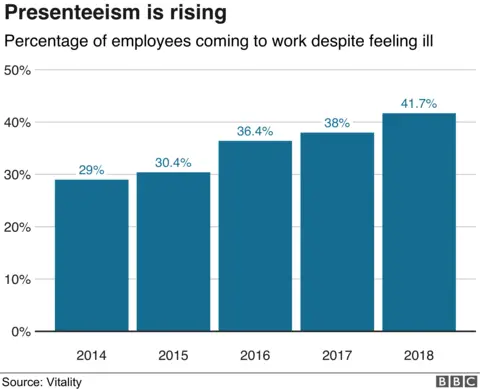
According to Deloitte, this costs bosses more than when staff take a day off.
But only 12.4% of people give mental health conditions as the reason for being off sick, according to the Office for National Statistics.
Nurses and teachers take more time off
Those working in the public sector are more likely to take time off because of mental health problems.
A total of 81% of people working in schools, the NHS, or the police said they always or usually go into work when they should take time off for their mental health.
This number increases to 85% for private sector workers.
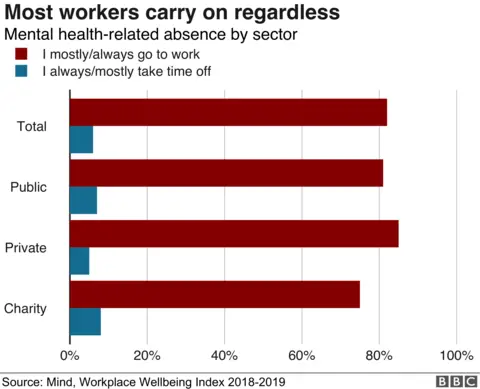
Previous research by the BBC found that the number of NHS mental health staff who had to take sick leave because of their own mental health issues had increased by 22% between 2012-13 and 2016-17.
At the time, the union Unite said that cuts to staff and services were putting extra pressure on NHS workers.
Young people are the 'most vulnerable'
Poor mental health among young people has been described as an "epidemic".
Younger members of staff are the most vulnerable in the workplace, according to Mind.
The charity found that young people are more likely to use their holidays instead of taking days off work when experiencing poor mental health.
Staff turnover, sickness and lost productivity cost employers about 8% of the average salary for a young person aged 18 to 29 years old in 2018 - roughly equal to £1,723 per employee.
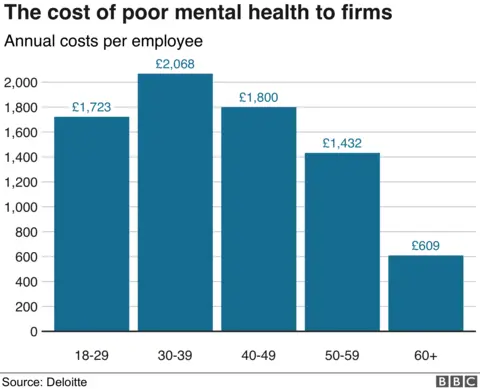
That was the highest proportion of salary of any age group, partly because young people receive lower wages.
Having grown up in the shadow of the financial crisis, money worries can seriously affect under-30s.
A total of 90% of young workers surveyed for Business in the Community said that their mental health is affected by the cost of living.
Under-25s now make up about 6.5% of all personal insolvencies, according to the Insolvency Service.
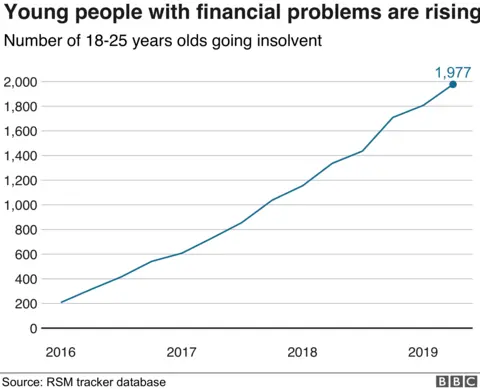
Experts have said that easy-to-access credit and less secure ways of working can create problems for young people.
They are also the most likely to take on more flexible, insecure types of work like driving for Uber or delivering food for Deliveroo. The TUC trades union body previously found that the number of people doing "gig economy" work had doubled within three years.
Details of organisations which offer advice and support can be found on the BBC's Actionline.
Or you can call for free, at any time, to hear recorded information on 0800 066 066.
